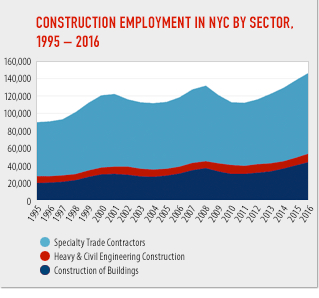
New York City (NYC) construction industry’s employment has reached its highest level in more than 40 years and easily surpassed the number of jobs created during the height of the previous building boom in 2008, according to a New York Building Congress (NYBC) analysis of New York State Department of Labor employment statistics available since 1975, NYBC reports in its most recent Construction Outlook Update.
In addition, the average annual wages earned by these workers increased by an estimated three percent in 2015, which represents the largest year-to-year increase since 2008, when wages rose by more than five percent from the prior year, the outlook reported.
“Each of the cranes currently dotting the New York City skyline represents thousands of jobs for local construction workers, three-quarters of whom live in one of the five boroughs,” said NYBC president Richard Anderson. “With nearly $40 billion in construction spending last year and the Building Congress forecasting more of the same this year and next, we should expect the construction industry to be a major driver of jobs for the foreseeable future.”
The outlook report says NYC produced 138,200 construction jobs in 2015, a seven percent increase from 2014, when 129,100 jobs were created. It continued:
Last year marked the fourth consecutive year of job growth and the highest level of construction employment in the City since at least 1975. The previous high water mark was 131,800 jobs in 2008.
Based on an analysis of jobs data from the first half of this year, the Building Congress estimates construction employment will climb even further to 147,100 jobs in 2016, which would be a 6.4 percent increase from 2015.
The specialty trades sector, which includes plumbers and electricians, accounted for 89,500 jobs in 2015, up from 84,300 jobs in 2014. Workers involved in the construction of buildings accounted for 40,300 jobs last year, up from 36,500 the prior year. The heavy construction and civil engineering sector, which is primarily involved in major infrastructure projects, produced 8,400 jobs, a slight increase from 8,300 in 2014.
NYBC estimates that wages earned by New York construction workers averaged $76,300 last year, an increase from $74,100 in 2014. These workers have experienced modest increases in their annual wages in recent years. Industry workers overall earned an average of $73,000 in 2013, $71,800 in 2012, and $71,200 in 2011. The biggest one-year increase over the past decade occurred during the final stages of the previous building boom, when average annual wages rose from $65,000 in 2007 to $68,300 in 2008.

The heavy and civil engineering workforce remains the highest paid in the industry. Based on the Building Congress’s estimates, workers in this sector averaged $120,700 in pay last year, up from $111,200 in 2014, $107,900 in 2013, and $101,600 in 2012.
Average wages for the New York City workforce involved in the construction of buildings increased to $73,300 in 2015, from $71,200 in 2014. The earnings of these workers had stagnated in previous years, averaging $70,200 in 2013, $70,100 in 2012, and $70,600 in 2011.
Workers employed by specialty trade contractors have also experienced a modest increase with wages that averaged $73,800 in 2015, up from $71,700 in 2014, $70,300 in 2013, $68,900 in 2012, and $68,300 in 2011.
“It is no surprise to see wages rising in the face of such intense demand for workers,” Anderson said. “That said, it is worth noting that wages are not rising nearly as quickly as they did during the previous building boom. This may be attributed to the growing number of union apprentices and the fact that the current boom is being fuelled in large measure by residential construction, which is increasingly going to less expensive non-union labor.”










Buckson, It’s a new record in the construction industry of New york. I hope the situation will get better soon after COVID-19.